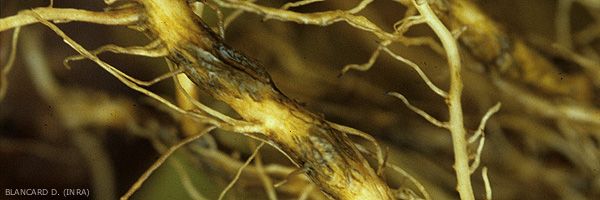
Sphingomonas suberifaciens (van Bruggen et al. 1990) Yabuuchi et al. 1999
Corky roots
- classification : Eubacteria, Alphaproteobacteria, Sphingomonadales, Sphingomonadaceae
- synonyms: Rhizomonas suberifaciens
- English name: Corky root
- English name: Corky root
Sphingomonas suberifaciens (Gram bacillus - difficult to isolate and therefore to identify) has been reported in several countries and, in the first place, in the USA, especially in plots where lettuce cultivation occurs frequently. In this country, it is rampant, especially in California and Florida, causing the "infectious corky root" of lettuce. It is also reported from Australia, New Zealand and Europe (in England and the Netherlands on iceberg lettuce; in Spain on Lactuca serriola ; in Greece on Sonchus oleraceus ). Symptoms of "Corky root" are also reported in Italy.
In France , the etiology of corky roots in lettuce has never been established, except in the case of attacks by Pyrenochaeta lycopersici , a fungus also responsible for corky damage on roots. Corky roots and pivots are also observed in crops without being attributable to this fungus; in this case, it does seem that they can be attributed to Rhizomonas suberifaciens . The frequency and severity of the damage recorded have never justified the etiology of this disease.
It should be remembered that some authors have associated with these symptoms the effects of phytotoxins released into the soil during the decomposition of green plant waste in very humid conditions. This situation is only very rarely reported. Excessive nitrogen fertilization has also been incriminated; they released too much ammonia and nitrites into the soil. In this case, we speak of the non-parasitic “big pivot” or “non-infectious corky root”.
It is quite obvious that in certain plots, one will be able to deal with the combined action of Sphingomonas suberifaciens and excessive nitrogenous manures. We will not systematically differentiate the large parasitic and non-parasitic pivots because their symptoms, as well as the control methods to be implemented to control them, are quite comparable.
This bacterium has been renamed in recent years; the name of Sphingomonas suberifaciens is now validated. A Rhizomonas sp. responding negatively to a monoclonal serum specific for Rhizomonas suberifaciens has been isolated in the Netherlands. It would also show a weak DNA sequence homology with the latter.
In France , the etiology of corky roots in lettuce has never been established, except in the case of attacks by Pyrenochaeta lycopersici , a fungus also responsible for corky damage on roots. Corky roots and pivots are also observed in crops without being attributable to this fungus; in this case, it does seem that they can be attributed to Rhizomonas suberifaciens . The frequency and severity of the damage recorded have never justified the etiology of this disease.
It should be remembered that some authors have associated with these symptoms the effects of phytotoxins released into the soil during the decomposition of green plant waste in very humid conditions. This situation is only very rarely reported. Excessive nitrogen fertilization has also been incriminated; they released too much ammonia and nitrites into the soil. In this case, we speak of the non-parasitic “big pivot” or “non-infectious corky root”.
It is quite obvious that in certain plots, one will be able to deal with the combined action of Sphingomonas suberifaciens and excessive nitrogenous manures. We will not systematically differentiate the large parasitic and non-parasitic pivots because their symptoms, as well as the control methods to be implemented to control them, are quite comparable.
This bacterium has been renamed in recent years; the name of Sphingomonas suberifaciens is now validated. A Rhizomonas sp. responding negatively to a monoclonal serum specific for Rhizomonas suberifaciens has been isolated in the Netherlands. It would also show a weak DNA sequence homology with the latter.





